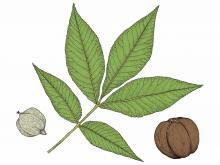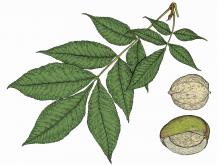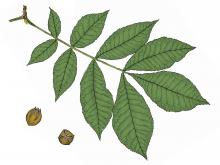Trees, Shrubs and Woody Vines
Media

Species Types
Scientific Name
Quercus nigra
Description
Its range and interesting, variable leaf shapes identify water oak. Like many species that require wet lowland forests, water oak has been declining in our state due to long-term extensive disruption of natural habitats in our Bootheel counties.
Media

Species Types
Scientific Name
Quercus lyrata
Description
Overcup oak is fairly easy to identify. The acorns are almost completely covered by their knobby cups. The leaves have long, narrow lobes and wide sinuses. In Missouri, it grows naturally only in wet forests along the Mississippi and Meramec rivers.
Media

Species Types
Scientific Name
Quercus bicolor
Description
A beautiful tree, swamp white oak features bicolored leaves that are shiny, dark green above and downy white below. When a breeze sets them in motion, their wavy or lobed shapes add a calm grace to a summer's hike.
Media

Species Types
Scientific Name
Quercus falcata
Description
This tree has two names as well as two leaf types! In Missouri, southern red oak, or Spanish oak, occurs natively only in our southeast and southernmost counties.
Media

Species Types
Scientific Name
Quercus pagoda
Description
The bark of cherrybark oak looks like the bark of a cherry tree. When you hold one of the leaves with the leaf stalk upward, the pointed lobes make the leaf resemble an outline of a Chinese pagoda. This oak grows in Missouri's Bootheel.
Media

Species Types
Scientific Name
Quercus alba
Description
Found throughout Missouri and in all kinds of habitats, the white oak is one of our most attractive, long-lived, and stately shade trees. Learn to recognize it by its light gray bark, rounded-lobed leaves, and distinctive acorns.
Media

Species Types
Scientific Name
Carya ovata
Description
Many Missouri trees are quite useful, and shagbark hickory is a great example. Its wood makes excellent, slow-burning charcoal, its nuts are edible, and its wood is used for many implements. Wildlife from moths to squirrels to bats appreciate shagbarks, too!
Media

Species Types
Scientific Name
Carya laciniosa
Description
Shellbark hickory is the largest of the true hickories and has the best-tasting hickory nuts in Missouri. Compared to shagbark hickory, it has larger leaves and more leaflets, plus larger nuts and orange twigs.
Media

Species Types
Scientific Name
Carya cordiformis
Description
Of the several hickories in Missouri, bitternut hickory is the only one with long, bright yellow buds. Its common name refers to the bitter taste of the nut — but the flavor doesn't put off squirrels, mice, and deer!
Media

Species Types
Scientific Name
Carya illinoinensis
Description
The pecan, a type of hickory, is one of Missouri’s favorite nut trees. Originally pecan had a fairly limited, southern distribution, but today it is found in and out of cultivation nearly statewide, owing to the popularity of the nuts.
See Also
About Trees, Shrubs and Woody Vines in Missouri
There are no sharp dividing lines between trees, shrubs, and woody vines, or even between woody and nonwoody plants. “Wood” is a type of tissue made of cellulose and lignin that many plants develop as they mature — whether they are “woody” or not. Trees are woody plants over 13 feet tall with a single trunk. Shrubs are less than 13 feet tall, with multiple stems. Vines require support or else sprawl over the ground.





















